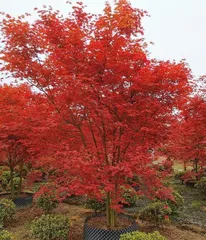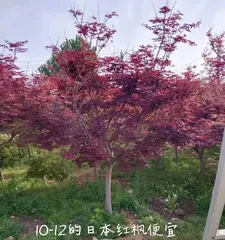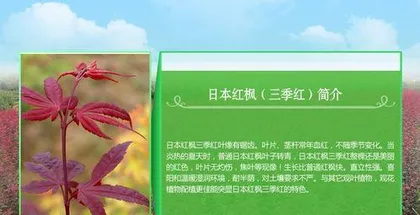Japanese Red Maple, with its graceful posture and rich colors, attracts countless tourists for viewing. However, many people do not know whether its growth speed is fast or not? Today, we will unveil the mystery of the growth of the Japanese Red Maple.

Introduction to Red Maple
Red Maple (scientific name: Acer palmatum) is a species of deciduous shrub or small tree in the genus Acer of the family Sapindaceae, native to China, Korea, Japan, and the Russian Far East. It can grow up to 10 meters in height, with leaves that are five-lobed or three-lobed, with vibrant and ever-changing colors.
Growing Environment
Red Maples prefer warm and humid climates, with a suitable growing temperature of 15-25°C. It is not demanding on soil, but it is best to have fertile and well-drained land. In Japan, Red Maples are mainly found in mountainous areas and urban parks.

Growth Rate
The growth rate of the Red Maple varies depending on factors such as climate and soil. Generally, its growth rate is relatively slow, with only a few centimeters of growth per year. However, in a suitable environment, its growth rate can be accelerated.
Seedling Stage
The seedling stage of a Red Maple is generally about 3 years. During this period, its growth rate is relatively slow, and attention needs to be paid to maintenance and fertilization.
Growth Period
The growth period of the Red Maple is generally from April to August. During this period, its growth rate will accelerate, and attention needs to be paid to watering and fertilization.

Maturity Stage
The maturity stage of the Red Maple is generally around 10-20 years. During this period, its growth rate will gradually slow down, but it can still maintain a certain growth rate.
Types of Red Maple Trees
There are many varieties of Red Maple trees, such as Honshu Maple, Osaka Maple, Hinode Maple, and Leaf-veined Maple. Each type of tree has different growth rates and forms.
Pruning Red Maple Trees
Pruning Red Maple trees can help them maintain a good shape and healthy condition, while also promoting their growth. Generally, pruning should be done in winter, cutting off dead branches and parts affected by pests and diseases.
Transplanting Red Maple Trees
Transplanting Red Maple trees requires attention to many details, such as digging the hole, controlling the root system, and watering at the right time. After transplantation, the tree needs to be cared for to ensure its growth and health.
Care for Red Maple Trees
Care for Red Maple trees needs to pay attention to aspects such as water, fertilizer, and irrigation. During hot and dry summers, timely watering is necessary. At the same time, attention should be paid to pest and disease prevention and control, and maintaining environmental hygiene.
Uses of Red Maple Trees
Red Maple trees can not only be used for ornamental purposes but also as decorative plants in courtyards and gardens. In addition, Red Maple can also be used as bonsai, becoming a popular indoor decoration.
Cultural Significance of Red Maple Trees
Red Maple trees hold a special significance in Japanese culture and are considered an indispensable symbol of autumn. They are not only a beautiful landscape but also represent people's reverence and gratitude for nature and life.
Protection of Red Maple Trees
As a precious cultural heritage, Red Maple trees need to be protected. In Japan, there are special agencies for the protection and management of Red Maples. At the same time, people should also strengthen their awareness of protecting Red Maples, so that they can forever remain a beautiful part of our landscape.
The Beauty of the Japanese Red Maple
The Japanese Red Maple attracts countless tourists to admire it with its unique beauty and rich cultural connotations. In autumn, the mountains are covered in red leaves, with red and yellow interwoven, forming a beautiful picture.
Although the growth rate of the Japanese Red Maple is relatively slow, the meaning and beauty it represents are irreplaceable. By studying the Red Maple, we can not only understand its growth patterns and characteristics but also better appreciate and protect this unique natural landscape.